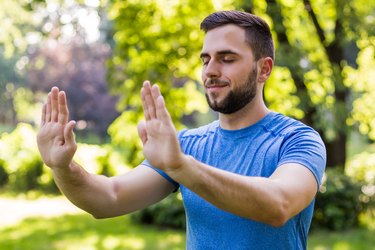
Tai chi, also called tai chi chuan, was developed as a martial art in 13th-century China. This meditative movement blends flowing movements and relaxation with deep breathing, and it's practiced worldwide as a health-promoting form of physical activity.
Ready to give tai chi a try and start your own practice? Learn some of the benefits this movement has to offer and a few exercises to get your started.
Video of the Day
Video of the Day
Related Reading
Tai Chi Movements for All Walks of Life
Though you may associate tai chi movements with older individuals, it has proven health benefits — like stress reduction, improved posture, balance and mobility and increased strength — for people of all ages. It's also accessible to people of all ability levels, including those who cannot stand.
There are several different types of tai chi, depending on the way you hold the postures and the speed of your movement. For the most part, though, the moves are quite gentle and many are done in a semi-squat.
If you're hoping to start practicing the martial art, it's best to study the ancient art under the guidance of an experienced teacher who can walk you though the basic tai chi moves.
Benefits of Tai Chi
Unlike high-intensity exercise, this practice involves slow, low-impact movements. But it still has a host of fitness-related perks. In fact, tai chi improves your muscle strength, flexibility, balance and aerobic conditioning, per Harvard Health Publishing.
And even though it won't leave you breathless like other forms of cardio training, tai chi improves your heart health. A February 2015 meta-analysis published in PLOS ONE found that tai chi enhanced cardiorespiratory function in healthy individuals.
In addition, tai chi can help promote weight loss. An October 2015 study published in Evidence-Based Complementary and Alternative Medicine found that people who practiced tai chi experienced moderate weight loss and saw a significant reduction in their waist circumference.
If it's back pain that ails you, tai chi's gentle movements may help you manage those symptoms too. Tai chi may help improve chronic lower back pain in older adults, according to a March 2020 study in The Journal of Alternative and Complementary Medicine.
And the mind-body exercise may also help promote brain health, specifically cognitive function and memory in older adults, according to a December 2013 meta-analysis in the Journal of Sport and Health Science.
Tai Chi Steps to Warm Up
There are a number of warm-up exercises you can do before beginning your practice. Warming up can get your focus, intent and breathing on track before you get into your basic tai chi moves. These warm-ups include:
- Head rolls: gently circle your head in one direction, then the other while breathing deeply
- Simple stretch: bending down to your toes and slowly coming back up with your hands on your hips
- Shoulder rolls: arm circles with your arms stretched out to the sides
- Picking fruit: standing with your feet shoulder-width apart and reaching upward
- Knee circles: standing with feet together, knees slightly bent and hands on knees as you circle your knees around together
- Hip rolls: standing with feet shoulder-width apart, hands on hips, and circling your hips as if you were hula hooping
Tai Chi Beginner Moves
These movements provide a great foundation for those looking to try tai chi, especially for beginners with no experience. After you try the warm-up exercises above, run through each of these moves for 2 or 3 rounds.
1. Warrior & Scholar
- Put your feet together and relax your hands at your sides.
- Take a breath in while bending your knees and sinking down, left hand flat and right hand balled up in a fist.
- Continuing to inhale, cover your right fist with your left hand and lift up.
- Come to a straight-legged stance.
- Exhale, release and sink back down.
2. Brush the Knee
- Begin this move in a T-stance.
- Lift one hand up, palm pacing front.
- The opposite hand is in front of the body, palm facing downward.
- As you bring one foot forward, twist your body at the waist and push your raised hand forward, while putting the opposite hand down.
- To finish, circle your arms back to starting position.
- Exhale on the push with the top hand and inhale on the circle back.
3. Part the Horse Mane
- Bring both hands in one on top of the other with a space in the middle, palms facing each other, as if you're carrying a ball.
- Shift your weight to whichever foot is on the same side as the top hand. So if your right hand is on top, shift your weight to your right foot.
- Bring the opposite leg in front and as you shift your weight to the front leg, move the bottom hand forward as if you're throwing a Frisbee.
- The other hand should come back and down to "rest on a large dog's head."
- NHS: A Guide to Tai Chi
- PLoS ONE :The Effect of Tai Chi Training on Cardiorespiratory Fitness in Healthy Adults: A Systematic Review and Meta-Analysis.
- Harvard Health Publishing: “The health benefits of tai chi.”
- Evidence-Based Complementary and Alternative Medicine: “Effects of Tai Chi and Walking Exercises on Weight Loss, Metabolic Syndrome Parameters, and Bone Mineral Density: A Cluster Randomized Controlled Trial.”
- American Journal of Epidemiology: “Associations of Tai Chi, Walking, and Jogging With Mortality in Chinese Men.”
- The Journal of Alternative and Complementary Medicine: “T'ai Chi for Chronic Low Back Pain in Older Adults: A Feasibility Trial.”
- Journal of Sport and Health Science: “The effects of Tai Chi exercise on cognitive function in older adults: A meta-analysis.”
- NHS: A Guide To Tai Chi
- YouTube: Tai Chi - Form 2 - Parting Wild Horse's Mane - Right & Left
- Complete Tai Chi: Home Study Manual